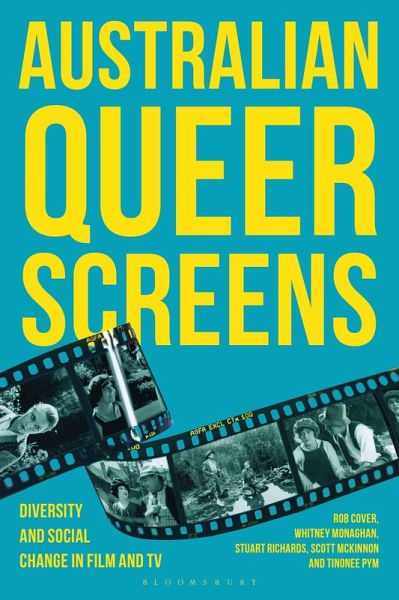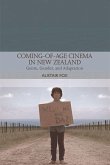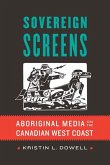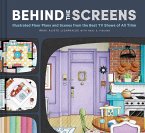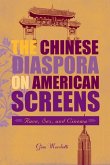Rob Cover, Whitney Monaghan, Stuart Richards, Scott Mckinnon, Tinonee Pym
Australian Queer Screens
Film and TV Diversity and Social Change
Versandkostenfrei innerhalb Deutschlands
121,99 €
inkl. MwSt.
Versandkostenfrei*
Erscheint vorauss. 5. Februar 2026
Melden Sie sich
hier
hier
für den Produktalarm an, um über die Verfügbarkeit des Produkts informiert zu werden.

61 °P sammeln
Rob Cover, Whitney Monaghan, Stuart Richards, Scott Mckinnon, Tinonee Pym
Australian Queer Screens
Film and TV Diversity and Social Change
- Gebundenes Buch
The first book-length study of Australia's rich history of LGBTQ+ film and television, covering histories, production, screen representation and audience identities.
Andere Kunden interessierten sich auch für
![Coming-Of-Age Cinema in New Zealand Coming-Of-Age Cinema in New Zealand]() Alistair FoxComing-Of-Age Cinema in New Zealand126,99 €
Alistair FoxComing-Of-Age Cinema in New Zealand126,99 €![Visceral Screens Visceral Screens]() Allan CameronVisceral Screens131,99 €
Allan CameronVisceral Screens131,99 €![Sovereign Screens Sovereign Screens]() Kristin L DowellSovereign Screens49,99 €
Kristin L DowellSovereign Screens49,99 €![Behind the Screens Behind the Screens]() Behind the Screens15,99 €
Behind the Screens15,99 €![American Television on British Screens American Television on British Screens]() P. RixonAmerican Television on British Screens38,99 €
P. RixonAmerican Television on British Screens38,99 €![The Screens of Virtual Production The Screens of Virtual Production]() The Screens of Virtual Production183,99 €
The Screens of Virtual Production183,99 €![The Chinese Diaspora on American Screens The Chinese Diaspora on American Screens]() Gina MarchettiThe Chinese Diaspora on American Screens76,99 €
Gina MarchettiThe Chinese Diaspora on American Screens76,99 €-
-
-
The first book-length study of Australia's rich history of LGBTQ+ film and television, covering histories, production, screen representation and audience identities.
Produktdetails
- Produktdetails
- Verlag: Bloomsbury Academic
- Seitenzahl: 224
- Erscheinungstermin: 5. Februar 2026
- Englisch
- Abmessung: 229mm x 152mm x 25mm
- Gewicht: 454g
- ISBN-13: 9798765128428
- Artikelnr.: 73944811
- Herstellerkennzeichnung
- Libri GmbH
- Europaallee 1
- 36244 Bad Hersfeld
- gpsr@libri.de
- Verlag: Bloomsbury Academic
- Seitenzahl: 224
- Erscheinungstermin: 5. Februar 2026
- Englisch
- Abmessung: 229mm x 152mm x 25mm
- Gewicht: 454g
- ISBN-13: 9798765128428
- Artikelnr.: 73944811
- Herstellerkennzeichnung
- Libri GmbH
- Europaallee 1
- 36244 Bad Hersfeld
- gpsr@libri.de
Rob Cover is Professor of Digital Communication at RMIT University, Melbourne, Australia. His publications include: Identity in the COVID-19 Years (Bloomsbury, 2024), Identity and Digital Communication: Concepts, Theories, Practices (2023), and Fake News in Digital Culture (2021), among many others. Whitney Monaghan is a Lecturer in Communications and Media Studies at Monash University, Australia. Her current research examines LGBTIQ representation on screen. She is the author of Queer Girls, Temporality and Screen Media: Not 'Just a Phase' (2016), and co-author of Queer Theory Now: From Foundations to Futures (2020). She is also a co-ordinator of the Melbourne Women in Film Festival. Stuart Richards lectures in Screen Studies at the University of South Australia. He is author of The Queer Film Festival: Popcorn & Politics (2016). He has previously worked with both the Melbourne Queer Film Festival and the San Francisco Frameline International LGBTQ Film Festival. Scott McKinnonis a PERL Research Fellow at the University of Wollongong, Australia. He has a research background in histories and geographies of sexuality, and the place of movies in Australian cultures, with a focus on film reception and memories of cinema among gay audiences. He is the author of Gay Men at the Movies: Cinema, Memory and the History of a Gay Male Community (2016). Tinonee Pym is a Research Associate on the ARC Discovery Project AusQueerScreen: Representation of Gender and Sexual Diversity in Australian Film and Television, 1990-2010 at RMIT University, Australia. She is a PhD Candidate in the Department of Media and Communication at Swinburne University, Australia, where her research focuses on queer community, sexuality and digital cultures.
Figures
Acknowledgments
1. Introduction: The Renaissance in Australian Queer Screen (Studies)
Part 1: Histories and Formations
2. The Politics of Film Representation
3. Australian Queer Television
4. Framing Politics: Filmgoing and Activism
Part 2: Australian Queer Film Production
5. Motivation and Impact among LGBTQ Screen Stakeholders
6. The Australian Queer Film Festival
Part 3: Reading the Australian Queer Text
7. Australian Queer Screen Criticism
8. Gender-Diverse, Trans, and Emergent Identity Frameworks in New Screen
Contexts
9. Historical Reception Practices, Policing, and Community Change
Part 4: Audience, Identity, and Culture
10. Australian Queer Screen Audiences: Place, Time, and Memory
11. Young Audiences, Mental Health, and Identity
12. Queer Screens and Social Change
13. Queer Australian Screen Futures and Affordances
References
Filmography
Index
Acknowledgments
1. Introduction: The Renaissance in Australian Queer Screen (Studies)
Part 1: Histories and Formations
2. The Politics of Film Representation
3. Australian Queer Television
4. Framing Politics: Filmgoing and Activism
Part 2: Australian Queer Film Production
5. Motivation and Impact among LGBTQ Screen Stakeholders
6. The Australian Queer Film Festival
Part 3: Reading the Australian Queer Text
7. Australian Queer Screen Criticism
8. Gender-Diverse, Trans, and Emergent Identity Frameworks in New Screen
Contexts
9. Historical Reception Practices, Policing, and Community Change
Part 4: Audience, Identity, and Culture
10. Australian Queer Screen Audiences: Place, Time, and Memory
11. Young Audiences, Mental Health, and Identity
12. Queer Screens and Social Change
13. Queer Australian Screen Futures and Affordances
References
Filmography
Index
Figures
Acknowledgments
1. Introduction: The Renaissance in Australian Queer Screen (Studies)
Part 1: Histories and Formations
2. The Politics of Film Representation
3. Australian Queer Television
4. Framing Politics: Filmgoing and Activism
Part 2: Australian Queer Film Production
5. Motivation and Impact among LGBTQ Screen Stakeholders
6. The Australian Queer Film Festival
Part 3: Reading the Australian Queer Text
7. Australian Queer Screen Criticism
8. Gender-Diverse, Trans, and Emergent Identity Frameworks in New Screen
Contexts
9. Historical Reception Practices, Policing, and Community Change
Part 4: Audience, Identity, and Culture
10. Australian Queer Screen Audiences: Place, Time, and Memory
11. Young Audiences, Mental Health, and Identity
12. Queer Screens and Social Change
13. Queer Australian Screen Futures and Affordances
References
Filmography
Index
Acknowledgments
1. Introduction: The Renaissance in Australian Queer Screen (Studies)
Part 1: Histories and Formations
2. The Politics of Film Representation
3. Australian Queer Television
4. Framing Politics: Filmgoing and Activism
Part 2: Australian Queer Film Production
5. Motivation and Impact among LGBTQ Screen Stakeholders
6. The Australian Queer Film Festival
Part 3: Reading the Australian Queer Text
7. Australian Queer Screen Criticism
8. Gender-Diverse, Trans, and Emergent Identity Frameworks in New Screen
Contexts
9. Historical Reception Practices, Policing, and Community Change
Part 4: Audience, Identity, and Culture
10. Australian Queer Screen Audiences: Place, Time, and Memory
11. Young Audiences, Mental Health, and Identity
12. Queer Screens and Social Change
13. Queer Australian Screen Futures and Affordances
References
Filmography
Index
